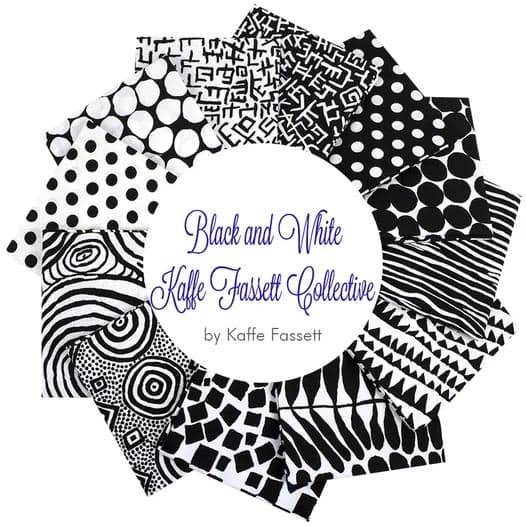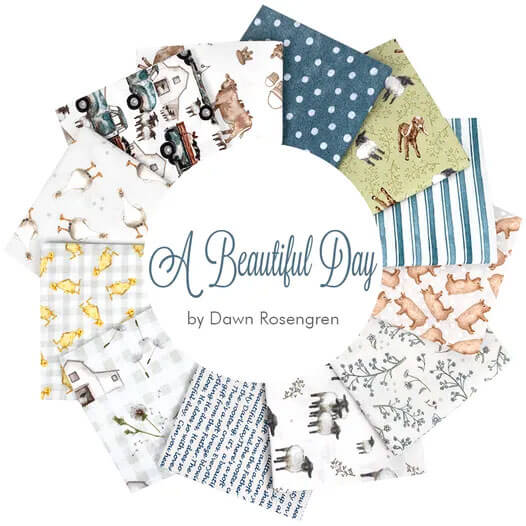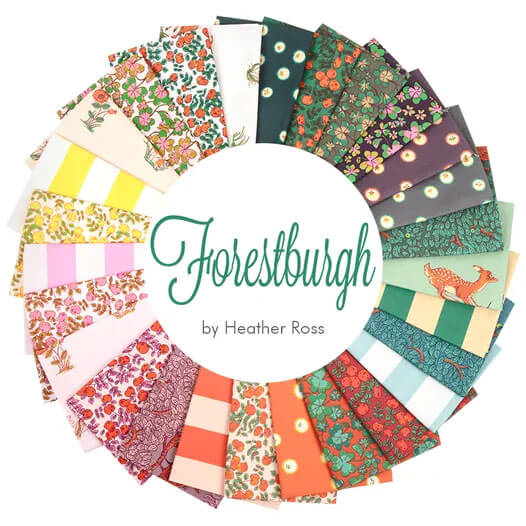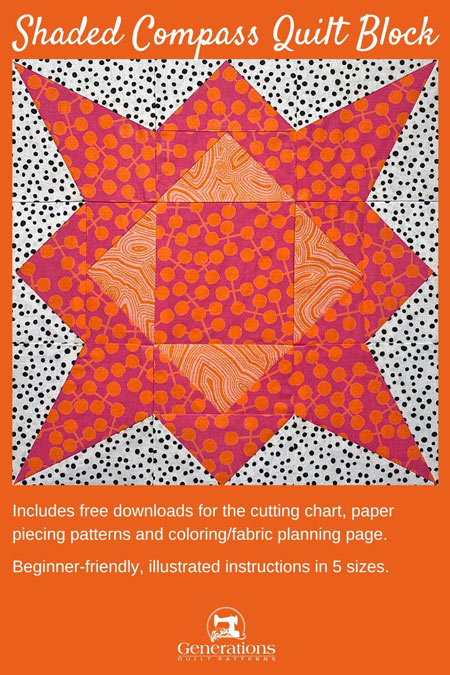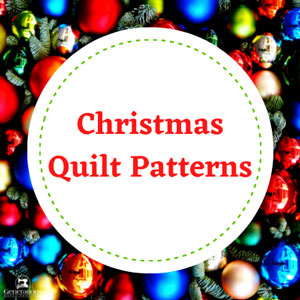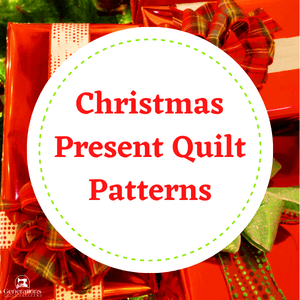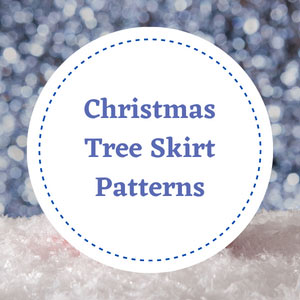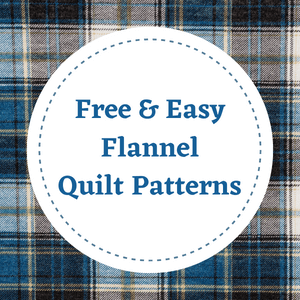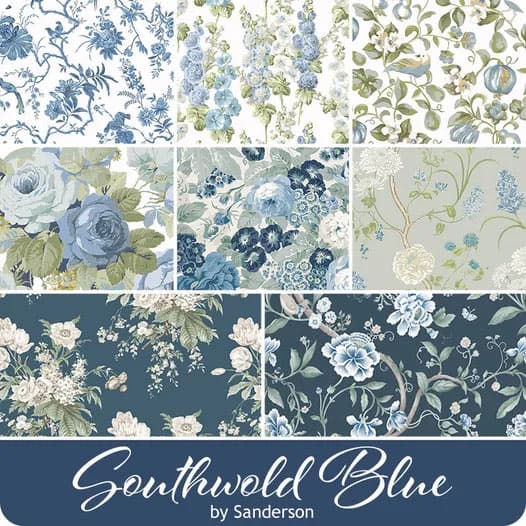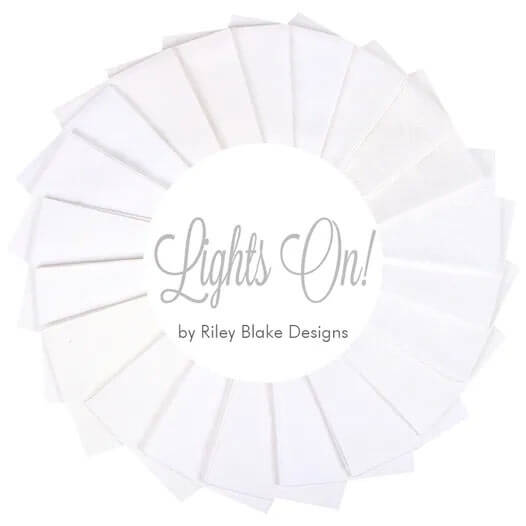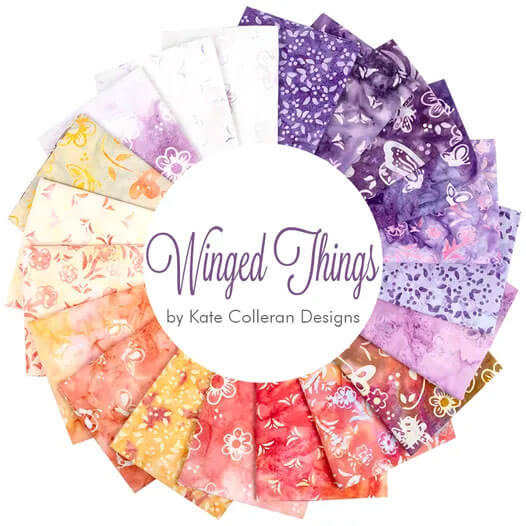- Home
- Free Quilt Block Patterns
- Shaded Compass Quilt Block
Shaded Compass Quilt Block: 6", 9", 12", 15", and 18" finished
From our Free Quilt Block Patterns Library
This post contains affiliate links, for which I receive compensation.
🚢 Land ho, fabric enthusiasts! The Shaded Compass quilt block has docked at our tutorial harbor, ready to guide you through new quilting waters.🧭
This paper-pieced beauty is your map to stitching treasure, with no need to keelhaul your wallet for specialty rulers. We've got free patterns in all 5 sizes, perfect for confident beginners and intermediate quilters looking to chart a course for new skills or brush up on old ones.
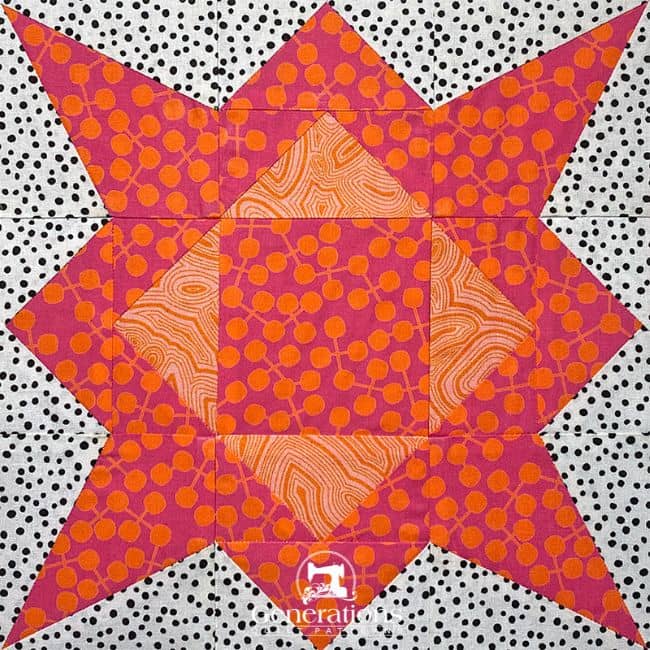
Don't be marooned on Boring Block Island—hoist your sails and let the Shaded Compass be your North Star to quilting adventure!
Use these links to quickly jump to where you want to go:
Cut. Sew. Press. It's full steam ahead!
📋General Instructions
Several abbreviations are used on this page. They are:
- SA - seam allowance
- RST - right sides together
- HST - half square triangles
- QST - quarter square triangles
- FG - Flying Geese
- CB - Corner Beam
A 1/4" SA is used in this tutorial.
Highlighted in yellow, pressing instructions are easy to spot.
First press the patches in the closed position as they came off your sewing machine. This sets the seam, melding the fibers of the threads into the fibers of the fabric.
Paper pieced seams are always pressed towards the last patch added...there are no other options,
Then press the SA as instructed.
Download and print the paper piecing patterns
To download the pattern, use the most current version of Adobe.
For accurate results, on Adobe's Print Menu page, under 'Page Size and Handling' set 'Custom Scale' to 100%. Then print.
Click here to see what it looks like on the Print Menu page.
Find your finished block size from the chart below. Print the corresponding number of pages for a total of four Corner Beams and four Flying Geese Pairs for each block you want to make.
Print CB and FG Paper Piecing Patterns and Templates |
|||||
|---|---|---|---|---|---|
| Finished Block Size |
Flying Geese Pairs | Corner Beam | |||
| Copies to Print |
Pattern | Copies to Print |
Pattern | Template | |
| 6'' | 1 | 2" | 1 | 2” | Print 1 |
| 9'' | 1 | 3" | 1 | 3” | |
| 12'' | 2 | 4" | 2 | 4” | Print 1 |
| 15'' | 4 | 5" | 4 | 5” | |
| 18'' | 4 | 6" | 4 | 6” | Print 1 |
After printing, use the 1" square graphic on the printed page(s) to double check that your patterns printed at the correct size.
Then cut out the required number of patterns from your copies. A rough cut is good enough—an 1/8"-1/4"-ish away from the outside dashed square.

Not sure which paper to use?
Take a look at my review of several of the most popular brands available to us quilters on the market.
You want a super-easy paper to tear away—less stress on the stitches.
The newest quilt fabrics to tickle your fancy...
Click the images below to see the full collection. We share any commercial and/or free patterns that showcase them, too. (For inspiration, of course!)
✂️
Cutting patches for a block
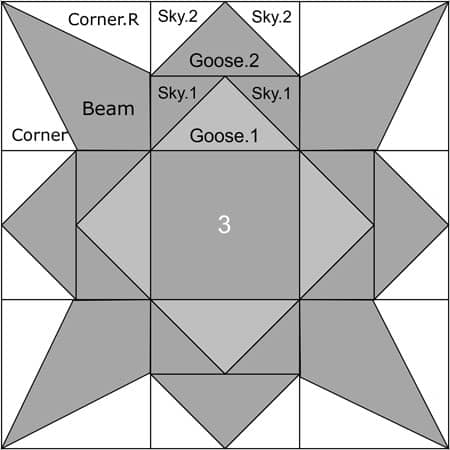 Shaded Compass design
Shaded Compass designSample Block Size: 9" finished / 9½" unfinished
Grid: 6x6
Design Type: Star | Even 9-patch | Paper piecing
Label your patches. We use their numbers throughout this tutorial. All are cut oversized, except the #3.
To print a copy of the block design and cutting chart to use at your cutting table, click here.
 | Cutting Chart for a~ Paper Piecing ~ | |||||||
|---|---|---|---|---|---|---|---|---|
| Patch | Fabric | Qty | Finished Block Size | Sub Cut | ||||
| 6'' | 9'' | 12'' | 15'' | 18'' | ||||
| Beam | Dark | 4 | 2¾'' x 2¾'' | 3¾'' x 3¾'' | 4¾'' x 4¾'' | 5¾'' x 5¾'' | 6¾'' x 6¾'' | yes |
| Corner, Corner.R | Bac | 4 | 2⅞'' x 3¼'' | 3⅜'' x 4¼'' | 3⅞'' x 5¼'' | 4⅜'' x 6¼'' | 4⅞'' x 7¼'' | yes |
| Goose.1 | Med | 1 | 3⅝'' x 3⅝'' | 4⅝'' x 4⅝'' | 5⅝'' x 5⅝'' | 6⅝'' x 6⅝'' | 7⅝'' x 7⅝'' | |
| Sky.1 | Dark | 4 | 2⅜'' x 2⅜'' | 2⅞'' x 2⅞'' | 3⅜'' x 3⅜'' | 3⅞'' x 3⅞'' | 4⅜'' x 4⅜'' | |
| Goose.2 | Dark | 1 | 3⅝'' x 3⅝'' | 4⅝'' x 4⅝'' | 5⅝'' x 5⅝'' | 6⅝'' x 6⅝'' | 7⅝'' x 7⅝'' | |
| Sky.2 | Bac | 4 | 2⅜'' x 2⅜'' | 2⅞'' x 2⅞'' | 3⅜'' x 3⅜'' | 3⅞'' x 3⅞'' | 4⅜'' x 4⅜'' | |
| 3 | Dark | 1 | 2½'' x 2½'' | 3½'' x 3½'' | 4½'' x 4½'' | 5½'' x 5½'' | 6½'' x 6½'' | --- |
| Unfinished Block Size | 6½'' | 9½'' | 12½'' | 15½'' | 18½'' | na | ||
| Grid Size | 1'' | 1½'' | 2'' | 2½'' | 3'' | na | ||
Subcutting
Starting first with the rectangles for the Corners of our CB unit, arrange the patches in pairs, right sides together. This is critical to creating the mirror-image triangles that we need.
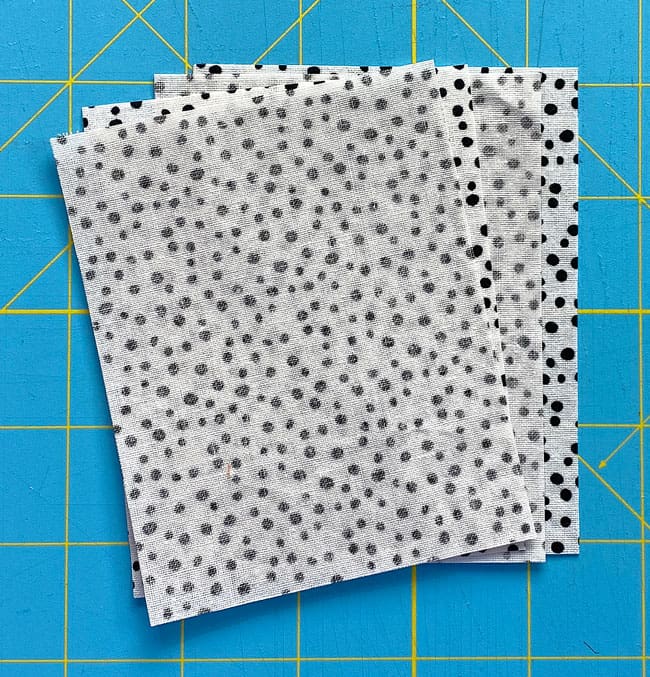
Match all the edges with the shorter width across the top and bottom edges.
With a pencil (I use a mechanical pencil for its consistent mark) make a mark 5/8" in from the top left edge and 5/8" in from the bottom right. (blue arrows)
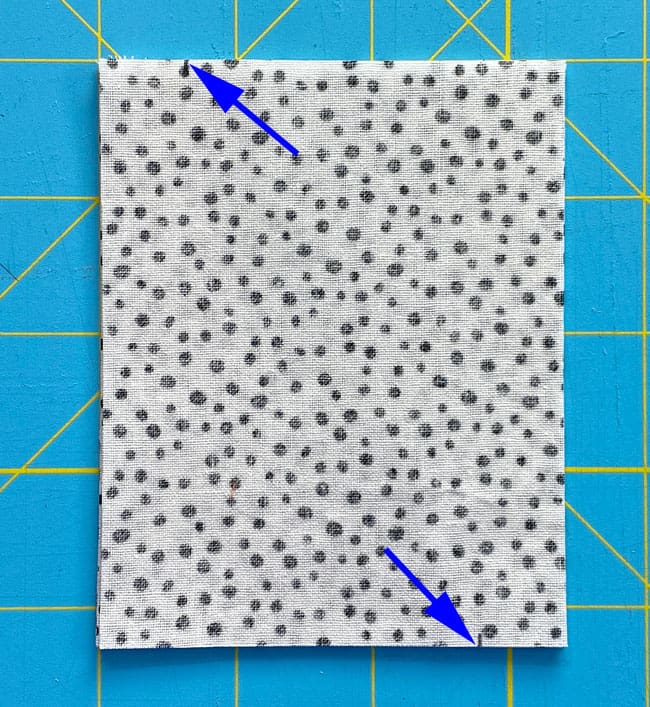
Match the edge of your ruler to these marks. Cut through all four layers.
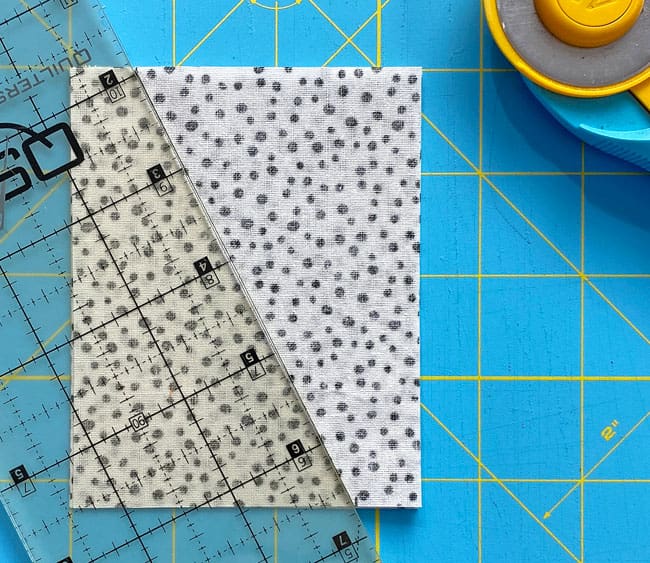
You end up with four pairs of mirror-image patches, our Corner.R and Corner.
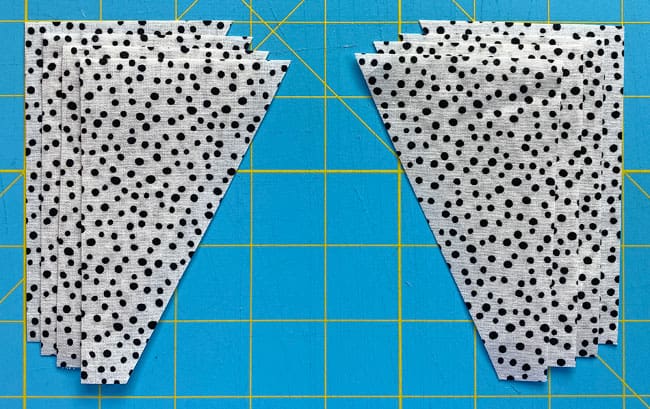
Layer all four Beam squares. This time, it doesn't matter if they're right side up or down.
Cut out the Beam template that corresponds to your finished block size. Match the corners of the template to the corners of your squares.
With your ruler lined up with one side, cut away the excess.
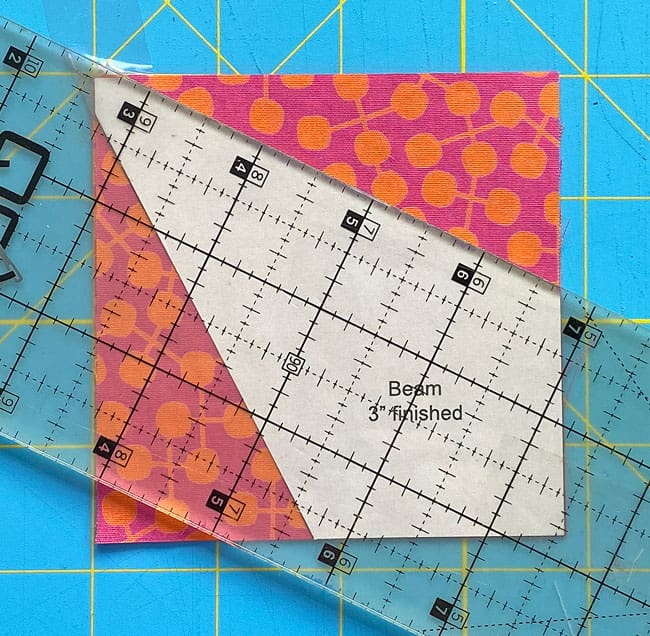
Remove the excess from the other side.
In the photo below, you can see that I taped the template down for cutting. It helps keep it from moving around as you subcut. Remove the tape from your mat and the template.
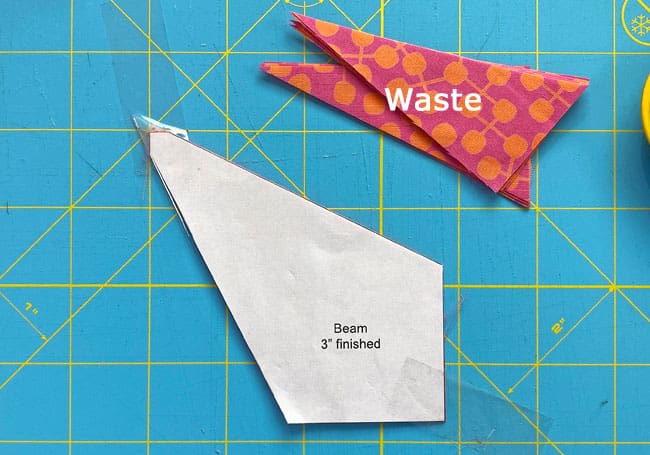
Here is how the patches will fit together. Narrow ends to narrow ends.
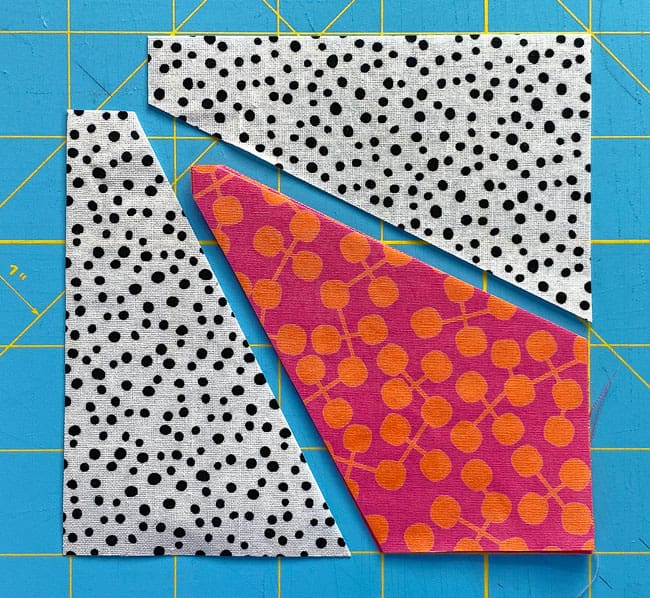
Subcut your Goose.1 and Goose.2 twice on the diagonal to form QST. Sky.1 and Sky.2 are subcut once to create HST.
Sky.1 and Goose.2 are the same fabric, close in size, and easy to get confused. Label them now to keep that from happening.
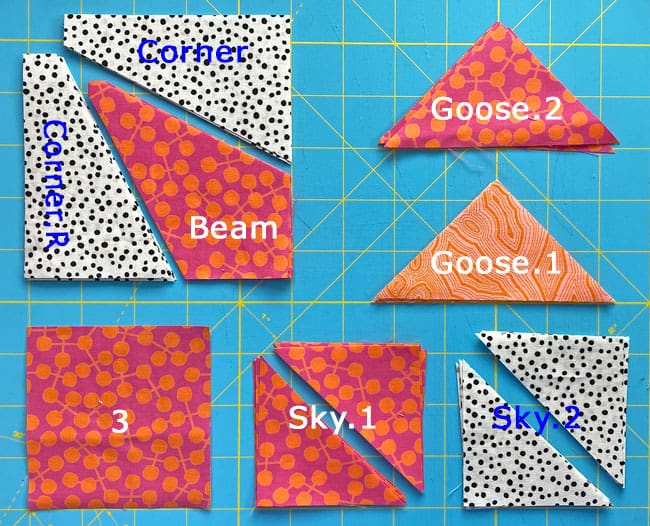
🪡Assemble your units for a Shaded Compass quilt block
Use a dab of Elmer's Washable Glue Stick&#reg; to hold the Goose.2 and Beam patches in position on their respective patterns. The dashed placement lines make this foolproof.
You're done with the glue stick, it can be put away.
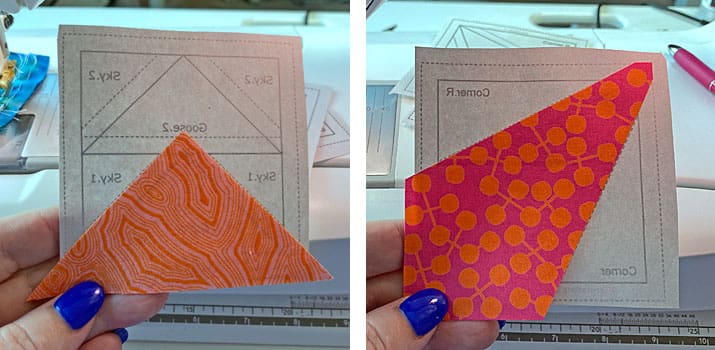
General Sewing Machine Setup for Paperpiecing
- Reduce your stitch length to 16–20 stitches per inch (1.3-1.6 mm). This perforates the paper and stabilizes the seam when you remove the pattern. [Learn more about stitch length here.]
- Reduce your machine's speed or just plain slow down. Sew only as fast as you can stay on the stitching lines.
- Install an open toe appliqué foot (sometimes called an 'embroidery' or 'satin stitch' foot) if you have one (it's easier to see where you're stitching with one installed).
- Use a larger needle (90/14) if you have problems removing the pattern.
- If your machine has a needle stop up, use it. The stitching goes faster when you don't have to lift the presser foot with every seam.
- As you stitch each seam, start and stop a generous 1/4” before and after the solid stitching lines. ALWAYS. Future lines of stitching secure the ends.
After adding each patch, press the unit as it was sewn to set the seam and then open. The SA is automatically pressed towards the last patch added.
Before adding the next patch, take a look to make sure the one you just added covers the space plus seam allowance that it is supposed to.
Steam is optional and usually curls the pattern.
If that bothers you, don't use steam. Sometimes I do. Sometimes I don't.
It truly depends on my mood.
Remember, as you follow this paper piecing tutorial, the printed and the fabric sides of this block are mirror-images of each other.
At last!
Let's sew!
Corner Beam (CB)
Make 4
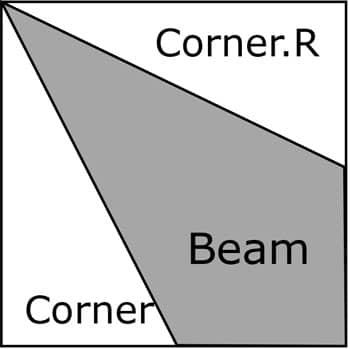
With RST, match the long edges of a Corner to the Beam. The Corners are cut oversized, so you've got some wiggle room. Use the photo below to help you position the patch.
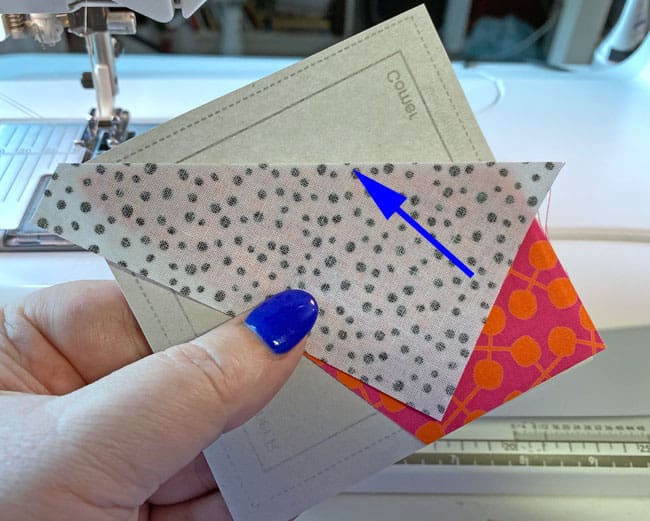 When adding a lighter patch over a darker one, to prevent the darker from shadowing through, nudge the top patch a few threads past the cut edge. (blue arrow)
When adding a lighter patch over a darker one, to prevent the darker from shadowing through, nudge the top patch a few threads past the cut edge. (blue arrow)Starting outside the dashed square that surrounds the CB, stitch on the solid line between Beam and Corner.1. End your stitches past the outside dashed lines. (All the seams in a CB can be chain pieced because they run from one side of the block to the other.)
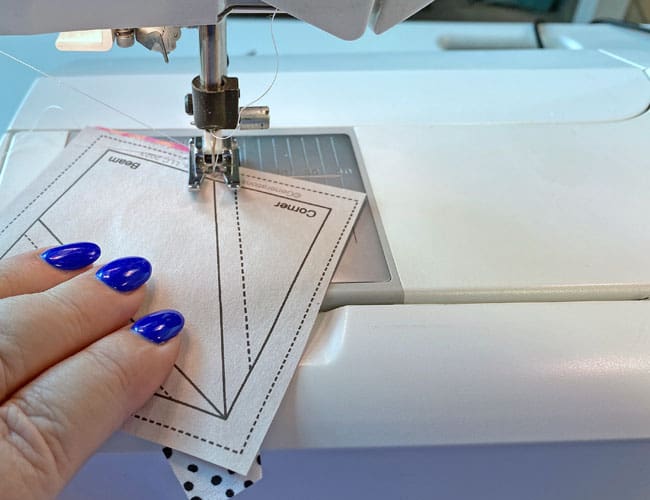
Don't bother with cutting the thread tails. We'll get those when you trim the unit to perfection.
Press.
Add the second Corner patch in the same way.
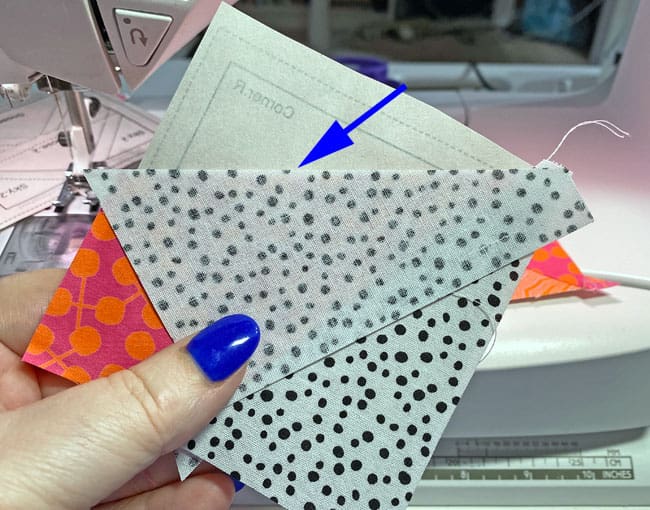 Again, this patch is nudges a few threads over to prevent the darker fabric from showing through the quilt top.
Again, this patch is nudges a few threads over to prevent the darker fabric from showing through the quilt top.Give the stitched CB a final press and it's time to trim.
At your cutting mat, printed side up, line up the 1/4" line on your ruler with the solid line on one side.
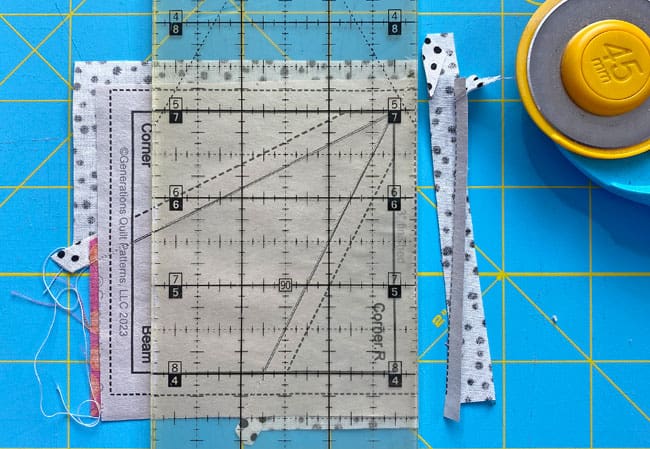
Trim away the excess.
Rotate the unit a 1/4 turn and repeat. Continue in this manner for all four sides of all four CBs.
You've got pieced perfection without a specialty ruler in sight. All for the cost of simply stitching on a line!
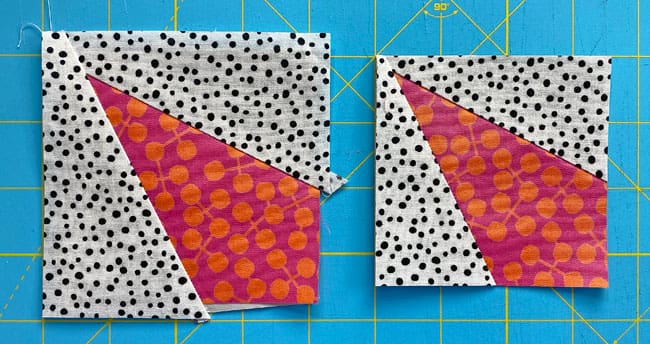 From hot mess to pieced perfection with 4 cuts.
From hot mess to pieced perfection with 4 cuts.Pairs of Flying Geese (FG)
Make 4
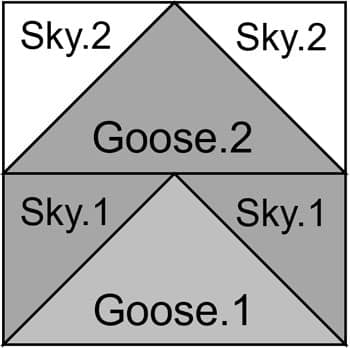
With RST, match a short edge of a Sky.1 with either short side of Goose.1.
It doesn't really matter which side you start with first. Being consistent is more important if you have a slew of these units to make.
You'll get into a good flow if you start consistently on the same side.
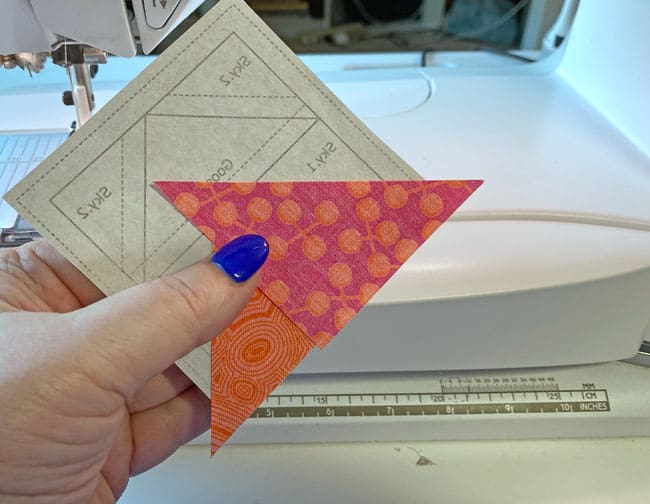
Stitch the seam, starting outside the dashed line that surrounds the block, onto the solid line and then past the end of that line for a generous 1/4".
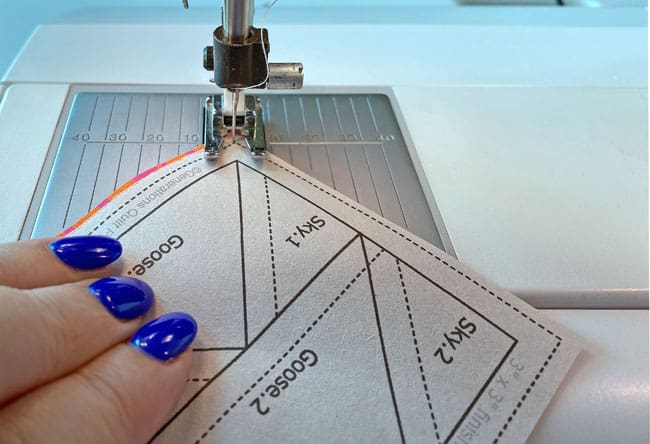
Trim away the thread tails in the center of the unit. Don't worry about those on the outside edges for now. We'll get to those later...efficiently.
Press.
Repeat for Sky.2, pressing when it's done..
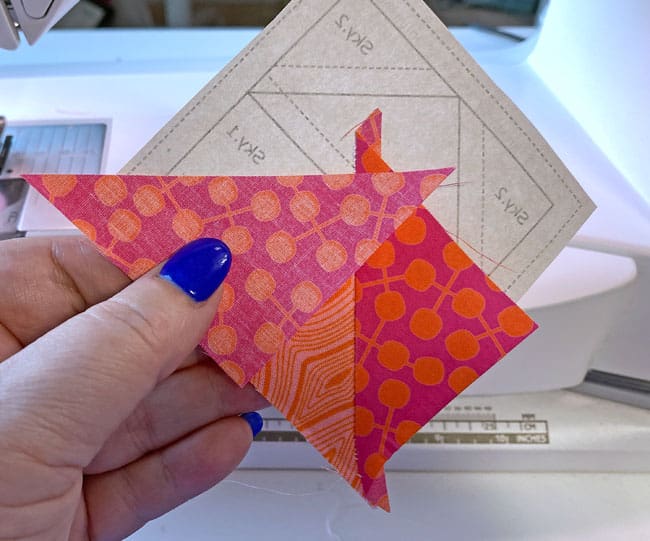
To create the perfect placement line for Goose.2, at your cutting mat, printed side up, match the edge of your ruler to the solid line between the two Sky.1s and Goose.2.
You'll need to pull the paper pattern away from the stitches (blue arrow) in the center. If the paper tears too much, repair it with Scotch Brand Magic Tape&#reg;.
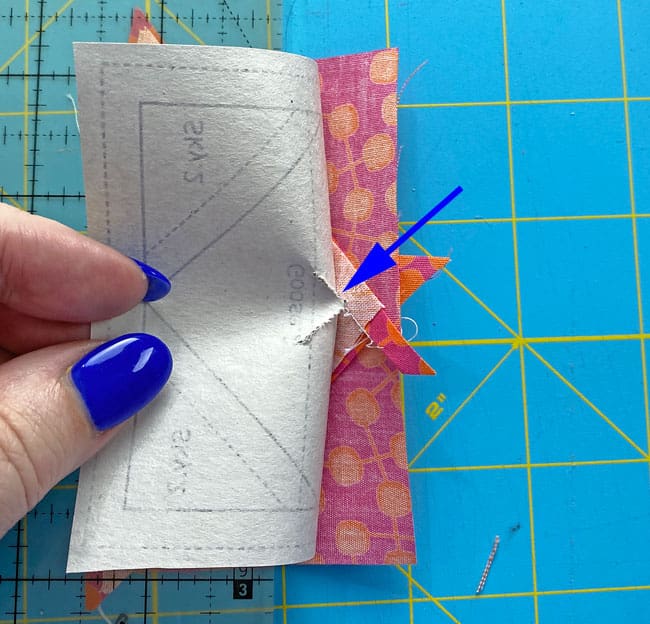
Use your fingernail to fold the pattern back on itself along this line.
Reposition the ruler with the 1/4" line now on the folded edge of the paper and cut away the excess fabric. This creates your accurate 1/4" SA. No need to guess where to position the Goose.2.
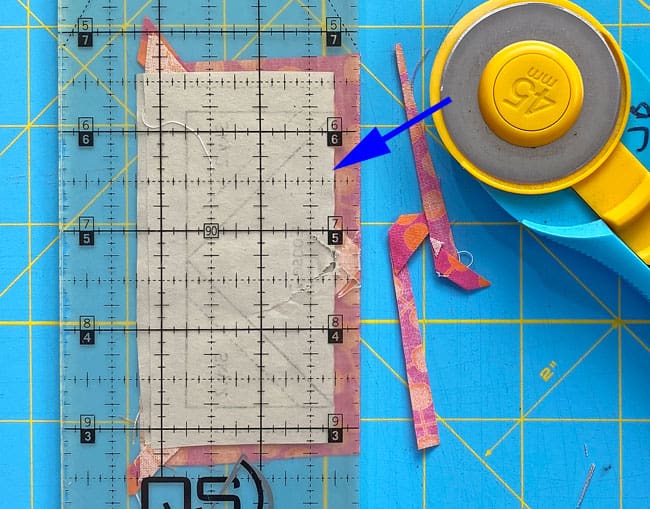
With RST, align the long edge of Goose.2 with the freshly cut Sky.1s.
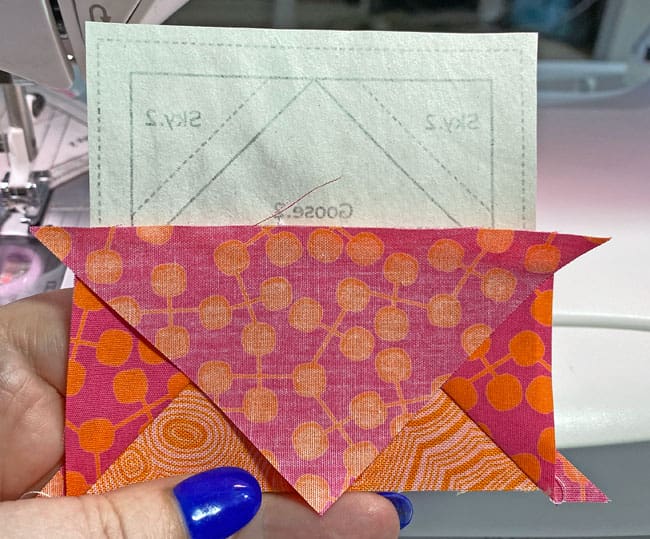 No need to nudge this patch, it's dark fabric over dark fabric.
No need to nudge this patch, it's dark fabric over dark fabric.Sew on the solid line, starting and ending past the outside dashed lines.
Again, this seam runs from one edge to the other, so you can chain piece it if you'd like to speed up the sewing.
Back at the cutting mat, trim the two exposed edges of Goose.2. 1/4" line on your ruler on the solid line between Goose.2 and Sky.2.
Fold the pattern back on itself. 1/4" line on the ruler on the fold (blue arrow), trim away the excess.
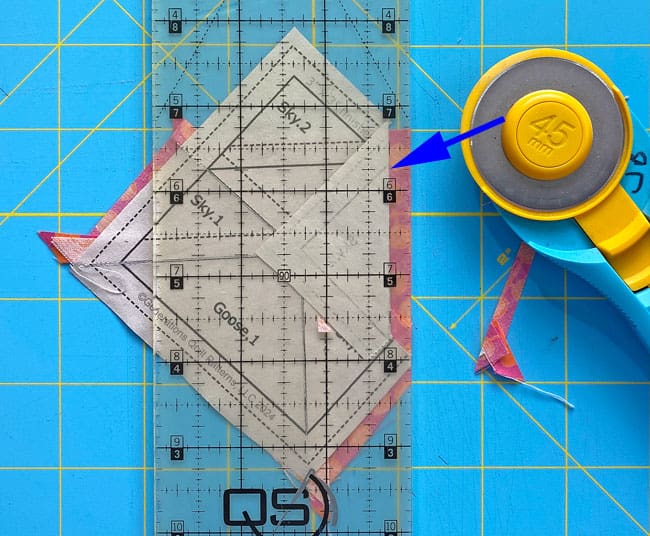
Repeat for the remaining side.
The Sky.2s are added just like the Sky.1s, except this time because our Sky2 fabric is so light, we'll nudge it a couple of threads past the edge of Goose2.
To prevent the darker fabric from shadowing through, of course!
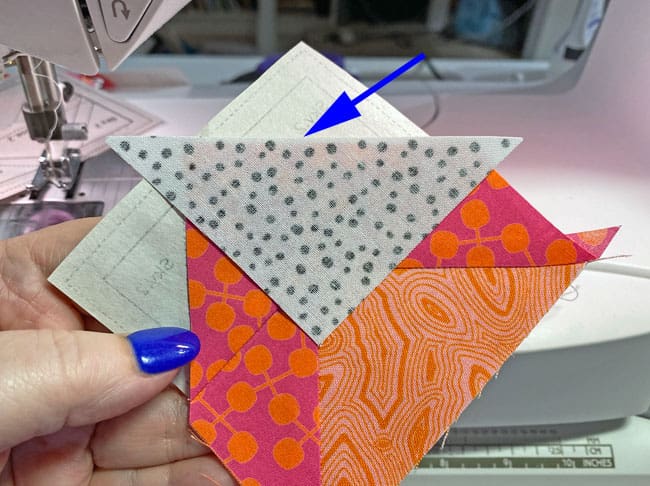
Press.
Add the second Sky2 in the same manner.
After sewing, give the FGs a good press.
At your cutting mat, printed side up, line up the 1/4" line on your ruler with the solid line on one side—just like you did for the Corner Beams.
Trim away the excess.
Rotate the unit a 1/4 turn and repeat. Continue in this manner for all four sides of all four CBs.
Pieced perfection, all for simply stitching on a line. Not a specialty ruler in site
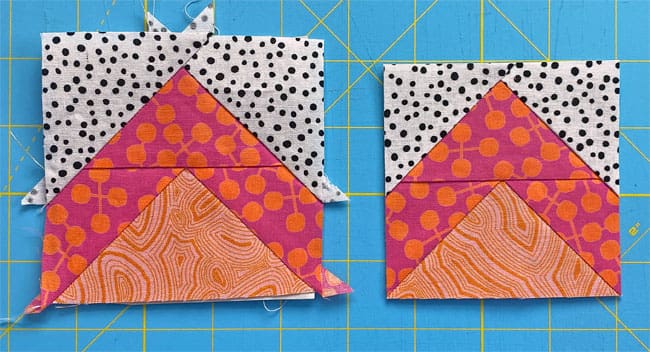

The paper piecing is complete. From this point forward, return your stitch length to the one you regularly use for piecing and install your favorite 1/4" presser foot.
Go ahead and remove all the paper from these units.
The patches were all cut so that after sewing, all the edges are on the straight of grain—exactly what you'd have if you used a specialty ruler or other traditional method to make them.
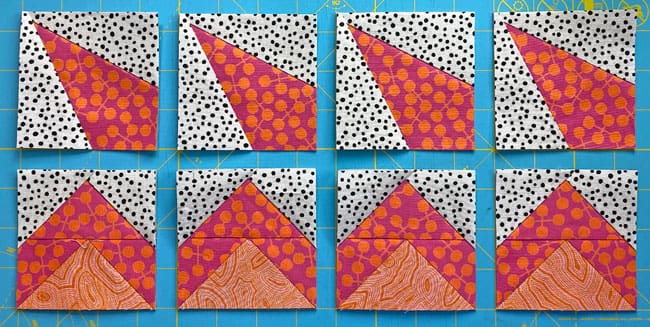
It's easier to remove now, rather than after you've sewed them together. Nothing to pick out of the SAs with a tweezerl
🧩Assemble your Shaded Compass quilt block
Arrange all your patches to form the Shaded Compass design. CBs in their usual corner position, #3 in the center, and our pairs of FG pointing outward on the sides.
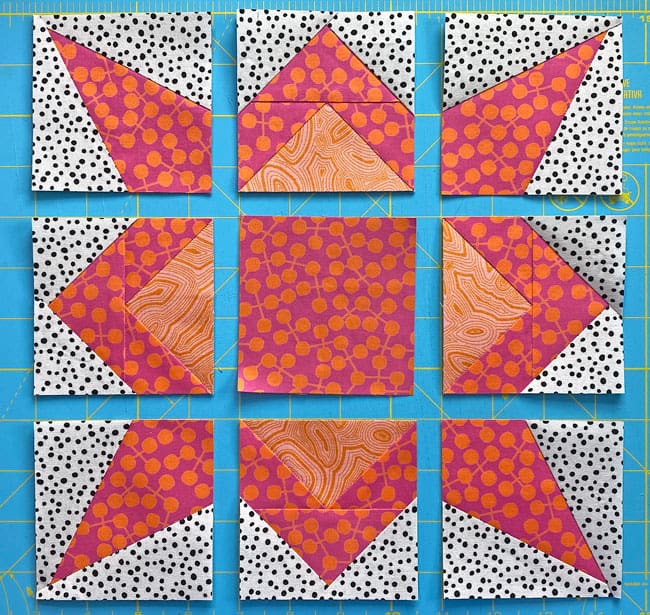
With RST, stitch the units in each row together. Pin as needed. If you've done a good job staying on the line, there will be very little pinning.
If you're concerned about matching seams and points, machine baste those match points first and check to see how you did. Rip if needed and re-sew. Or simply sew back over your basting with a regular stitch length when you're happy with the match.
A fine 50wt 100% cotton thread like Aurifil (orange spool) makes this possible without a lot of build up in the seam.
Press all the seams away from the bulkier FG units.
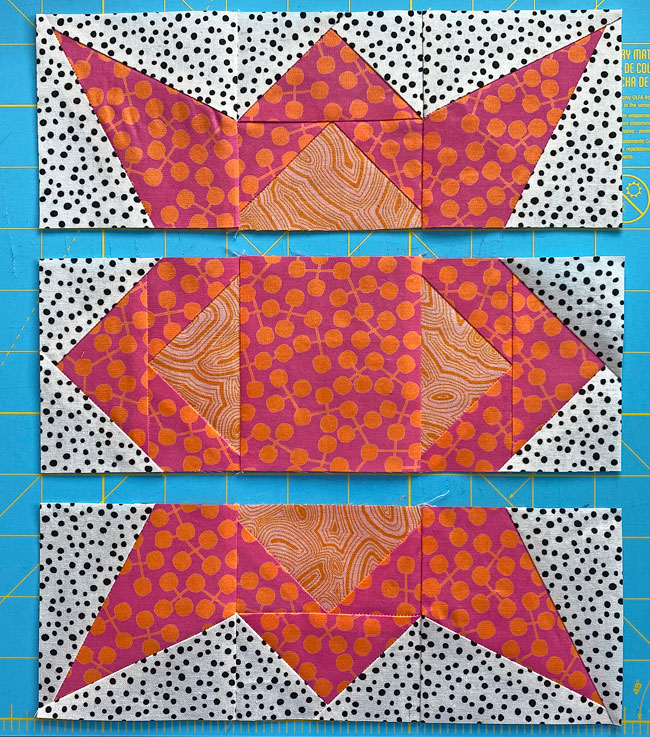
Stitch the units in each row together. I've pinned the finished block on my design wall to get a better lit photo...seems I went a little overboard with the pins. (Clearly not caffeinated enough this morning...)
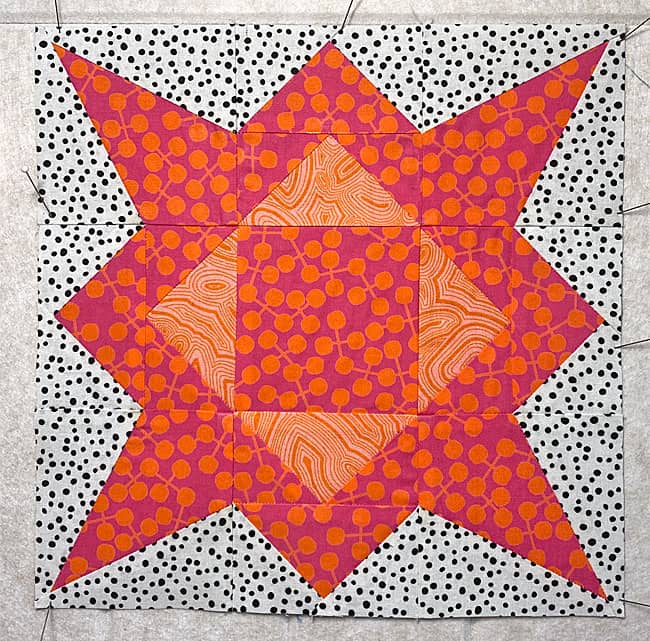
Finally, a peek at the backside of the block to see how the pressed SAs look.
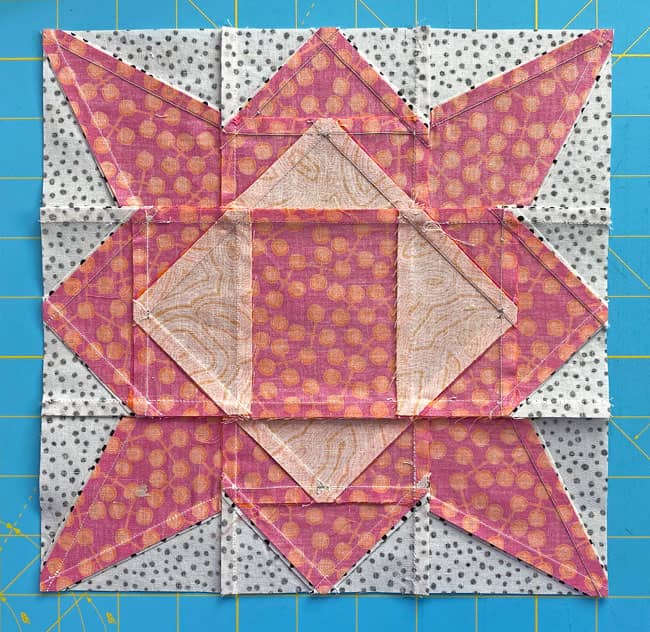
🔭 Looking for something truly stellar?
You've finished your star quilt block, and you're ready for more!
Browse our collection of 70 stellar star quilt block patterns. All have instructions and cutting charts in multiple sizes. If templates or paper piecing is used in the tutorial, there's a free download for you of those materials.
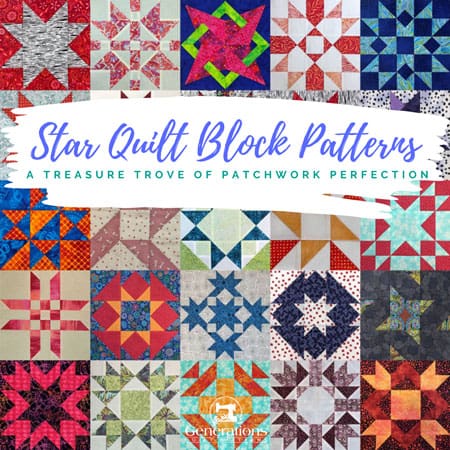
Eeny. Meenie. Miney. Moe.
Which star quilt block will you sew?
For a star-studded quilting experience, choose from 100+ bedazzling star quilt patterns—for beginners and beyond—click here.
For even MORE blocks to make… 🧩🎨

...visit our Free Quilt Block Pattern Library, with over 260+ blocks to choose from in multiple sizes.
Free downloads are included in all sizes for any blocks require paper piecing patterns or templates.
- Home
- Free Quilt Block Patterns
- Shaded Compass Quilt Block
